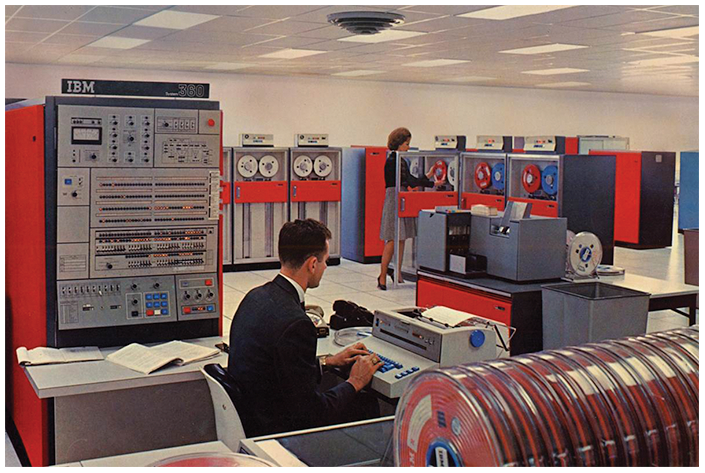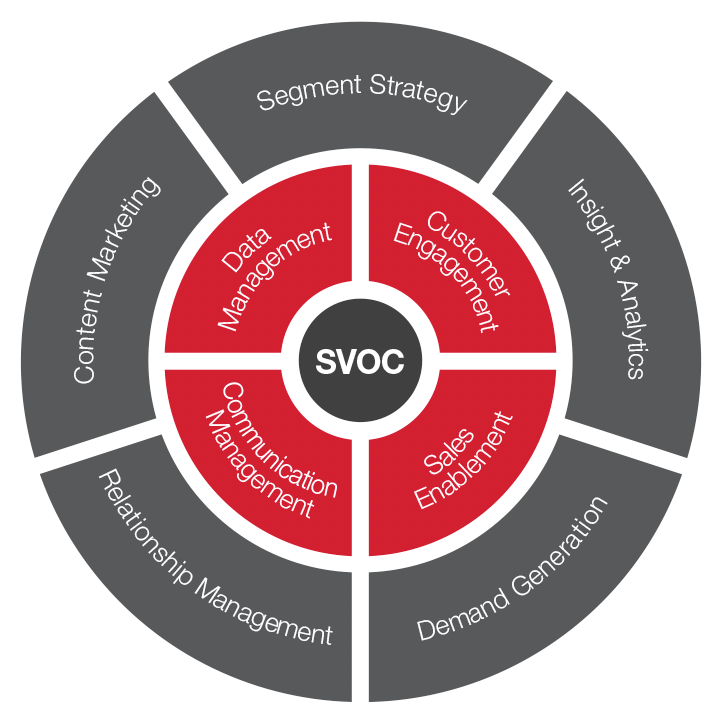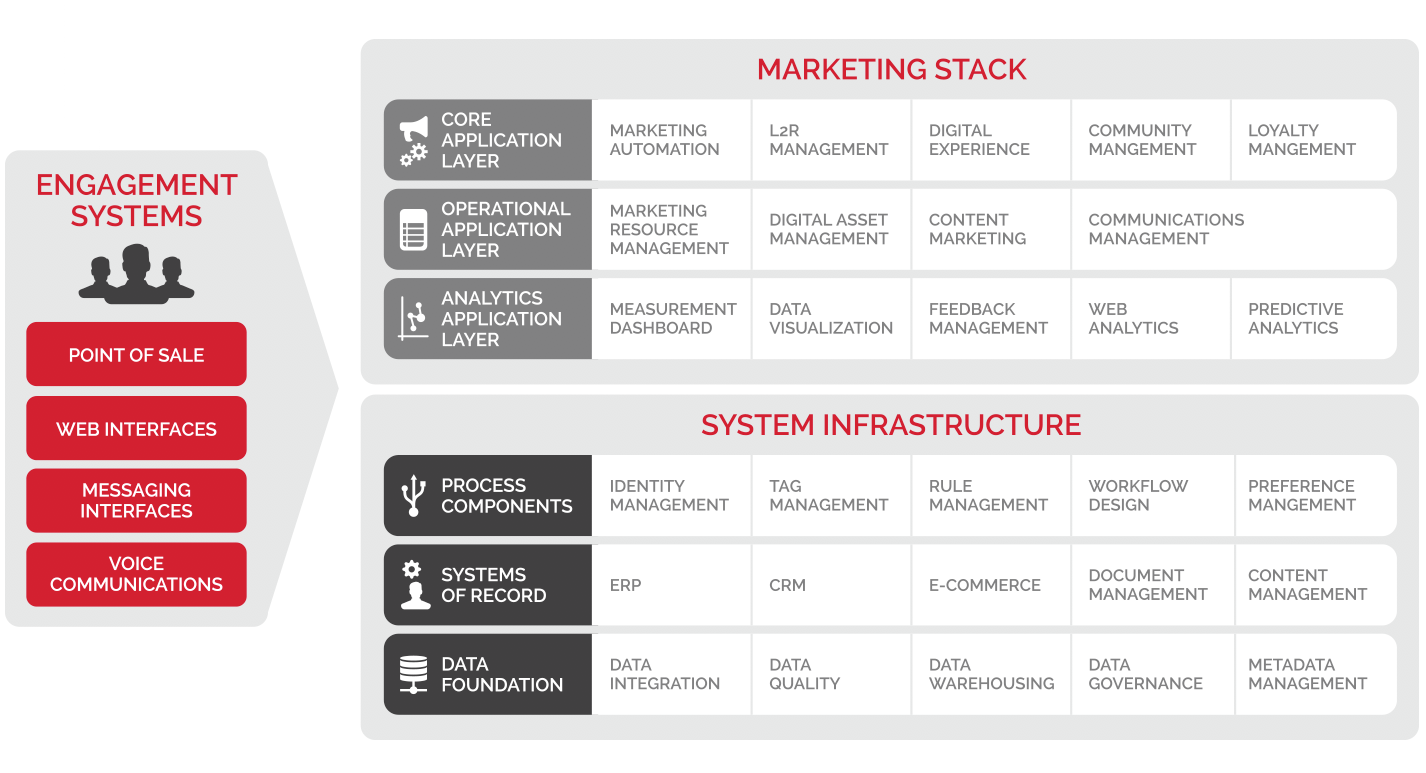The Marketing Ecosystem
Half a century ago IBM revolutionized the computing business by separating programs from hardware. Today a comparable revolution is underway: the shift to browser-based applications in the cloud. But that poses a dilemma for marketers: how do they combine multiple standalone applications to form a unified marketing ecosystem?

At the time it cost $2 million to buy. It was kept on a raised floor in a climate-controlled room. Emblazoned across the front of it was a sign with a single word: Think.
The IBM System/360 was introduced to the world in April 1964 with the promise: “Now one new computer fills all your data processing needs”. For the first time a mainframe computer could be used for multiple purposes. Any program that worked on one IBM model could work on others, meaning it was easy for businesses to upgrade. And that modularity and scalability not only revolutionized the computer industry, it helped IBM rule the mainframe world for the next three decades.
Those same principles are behind the latest computing revolution: the shift of applications from licensed software systems to hosted solutions in the “cloud”, known as “software-as-a-service” (SaaS, for short). Just as the IBM System/360 decoupled programs from hardware, these standalone applications operate independently of big monolithic systems (like SAP). Performing specialized business functions, they can be connected to form a single ecosystem. And it is that development, more than any other computing revolution preceding it, which promises to transform the practice of marketing.
What makes SaaS so appealing is the “pay as you go” subscription model. No need to involve IT. No software or hardware to install. No perpetual licensing commitments or support fees. Salesforce was the first technology company to prove the model works – and since then a deluge of sales and marketing applications has flooded the market, with new start-ups springing up all the time.
Fixing the Plumbing

To truly appreciate the impact on marketing of this new epoch you only have to think back to the mainframe era. Computing time was so precious marketers could rarely justify its use for much more than sales reporting and the generation of mailing lists. Companies that could not afford the price tag of their own “big iron” used computer service bureaus to do their bidding. But after PCs entered the scene in the mid-1980s, many marketers turned to more affordable desktop marketing systems to run their campaigns, using customer data pulled out of mainframes.
The arrival of CRM systems in the mid-1990s to support sales and service introduced new data siloes, complicating the picture for marketers desperate for a single view of the customer. But at least it forced technology departments to confront the problem of data fragmentation. Soon most large businesses were drawing up battle plans for “enterprise data warehouses” of which a consolidated customer database was intended to play a lead role. Often those projects collapsed under their own weight, mainly due to the complexity of reconciling so many disparate sources of internal data, not to mention the task of pleasing many different levels of information users, of which marketing was almost always the least influential.

Seeing an unserved gap in the market, software vendors pounced on the opportunity to build “enterprise marketing suites” with their own proprietary data models which could automate cross-channel campaign management. Marketers had been struggling to manage multi-channel campaigns, and these new licensed software suites were like Swiss army knives, promising to do it all, from list segmentation to response reporting. But once installed they were fiendishly complex to operate, often stumbled on the same data management issues befuddling internal systems architects, and failed to gain much of a foothold outside of companies with large addressable customer databases (like banks, retailers and mail order companies).
Many of the so-called “best in class” solutions (notably: Neolane, Aprimo, Unica, Responsys, Silverpop and ExactTarget) have since been gobbled up by the current oligopoly of computer vendors (mainly, IBM, Oracle, Adobe and Salesforce) which have been on a feverish multi-billion dollar buying spree, rushing to build an “all in one” platform referred to as “marketing in the cloud”. Each is on exactly the same mission, to make the (where have we heard this before?) claim: “Now one solution to meet all of your marketing automation needs”.
The idea of a single unified platform remains a chimera, since all of these vendors are now faced with integrating the various applications they’ve bought.
Of course, the idea of a single unified platform remains a chimera, since all of these vendors are now faced with integrating the various applications they’ve bought. But given the size of the market, which is projected to grow at a 12% compound annual growth rate to $32 billion by 2018, they are throwing as much money at the problem as they can, knowing the payoff could be huge. Forrester analyst Corey Munchback explains, “The plumbing needs to be in place to knit together the different applications which is data, content, workflows and business rules. Without that plumbing in place, these suites are not really a thing. They’re a portfolio of capabilities.”
Plug and Pray
As the “marketing cloud” vendors race each other to a finish line which keeps moving, companies everywhere are feeling the heat from digital disruption. Customers are increasingly demanding real-time support and service and that has put immense pressure on IT departments to upgrade their aging infrastructure. But IT is unable to move fast enough, held back by a culture of risk aversion. They see themselves as custodians, not change agents. Frustrated with the glacial pace of IT procurement, marketers have begun to search for answers on their own, carving money out of their budgets for technology acquisition. But with so many web-based solutions to choose from (see sidebar), marketers are faced with the formidable task of selecting, assembling, and connecting a mishmash of applications into some kind of “marketing stack”, something they would ordinarily expect IT to look after.
Just for starters, marketers need marketing automation tools to support outbound targeting and response tracking; operational applications to help with resource management and content production; voice of customer and social listening platforms to conduct surveys and monitor customer feedback; lead management software to nurture prospects through the sales funnel; and of course an analytical workbench encompassing data visualization and data mining tools. Beyond those core applications, there are all kinds of other niche technologies to think about, ranging from word-of-mouth applications to loyalty management solutions to video ad platforms.
IT is unable to move fast enough, held back by a culture of risk aversion. They see themselves as custodians, not change agents.
Mapping out the ecosystem components is just the first step. The tough job is integrating these various applications and connecting them to the existing infrastructure. But unifying these many different applications is the major challenge since they do not share a common information backbone. Most enterprises already own an alphabet soup of established platforms which form the technology foundation of their business (ERP, CRM, WCM, DAM, CCM, DDP, EDW, BI, the list goes on). They are usually connected by middleware which orchestrates the cross-platform movement of data, usually through “application programming interfaces” or an “enterprise service bus” that lets applications talk to each other by shunting messages back and forth. But when additional point solutions are layered on top of this environment, the platform architecture starts to resemble a shaky scaffolding (more “frankenstack” than “marketing stack”). Getting these applications to work in harmony is like conducting an orchestra of deaf musicians. And when you factor in data privacy and security protocols, the idea of “plug and play” becomes more like “plug and pray”.

Centre of Excellence
Getting these applications to work in harmony is like conducting an orchestra of deaf musicians.
As much trouble as integration may seem, it is worth the effort. Companies that have created a unified “marketing stack” are experiencing success delivering more connected experiences for their customers. However, they usually have to take an unorthodox route to get there, bypassing IT by setting up “centers of excellence”, staffed by marketing technologists and data analysts. The use and governance of marketing technology demands a different set of skills than designing communication programs. Someone has to make sure the systems are running properly. Someone has to oversee the configuration of applications. Someone has to be constantly on the lookout for the “next best thing”. Someone has to negotiate the subscription contracts. On top of all that, marketing users have to be trained on the different applications.
Freed from relying on IT to evaluate, install and maintain software (never a fun process), this specialized marketing team is given an operating budget to source their own technology. At the same time, it serves as a bridge between IT and marketing, reporting to the CMO but with a dotted line to the CIO. That way they can avoid straying too far from the enterprise technology strategy and can call upon the technical cavalry when needed.
Companies that have created a unified “marketing stack” are experiencing success delivering more connected experiences for their customers.
Ideally, the team’s mandate extends beyond technology evaluation and support. Because the fuel to run the marketing engine is customer data. So that group must also take ownership over the collection and aggregation of knowledge to drive customer insight; the creation of rules to guide customer treatment; and measurement of the interaction experience. All of the various systems of engagement – email, social, mobile, point-of-sale, web – must be connected to a single pooled repository of interaction data so that marketers can deliver more contextual experiences through the triggered application of business rules.
As the universe of niche marketing applications continues to expand, and connected customers apply greater pressure on businesses to serve them relevant information, it will be more critical than ever for companies to build integrated marketing ecosystems. Half a century may have passed since the advent of the IBM System/360, but the need for modularity and scalability are greater than ever.
Stephen Shaw is the chief strategy officer of Kenna, a marketing solutions provider specializing in customer experience management. He is also the host of a regular podcast called Customer First Thinking. Stephen can be reached via e-mail at sshaw@kenna.ca